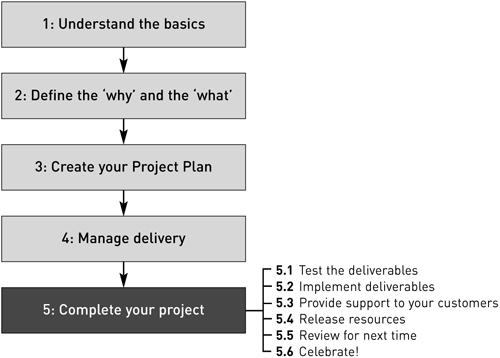Setting the scene
|
|
Step 5. Complete your project
The activities described in this chapter are performed at the end of a project. However, the tasks described take time and use up resources, and so they need to be included in the Project Plan. Hence in Chapter 3, I proposed reviewing the contents of this chapter to ensure the tasks are planned in advance. The tasks in this chapter are often essential to a successful project, and so they need to be built into project plans and budgets.
Suppose you have been running a project to write a small piece of computer software for a business. The project team of five people has worked on this for six weeks and has just completed writing the software. Is your project over? No. There are still some things to do. First, just because you have written the software, it does not mean it works properly the software has to be tested. Once it is tested you may have greater confidence that it works, but will your customer be able to use it? Normally you have to spend some time installing it onto your customer's computers and showing them how to use it, and possibly running some structured training in other words, the software has to be implemented. Having implemented the software, a few days later they may have some additional questions or they may identify a bug that your testing did not pick up. So it is usually good practice to provide some support to your customer for a limited period after the deliverables have been handed over, to answer their questions and fix any faults they find. Now you can start to close your project down. The project team can be 'released', that is let go to work on another project to develop some other software. But you probably don't want them all to go at once. They should be let go at different times, as the relevant parts of the project complete. Also, any money you have not spent from your Project Budget needs to be given back to your customer. If you are never going to run a project again perhaps you can stop now. However, if you think you might run projects in future, it is worth reviewing this whole software development project what did you do really well, and what could have been done better? If you know what to do better and what was done well, when you start to develop your next piece of software you should do it even more successfully. If the project was a success and your customer was happy with the software you developed, it may be worth having a small celebration. You deserve it, after all you have completed a project! |
|
Top of Page

